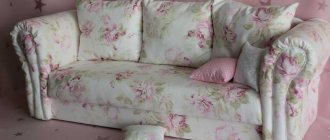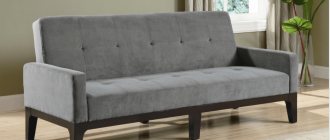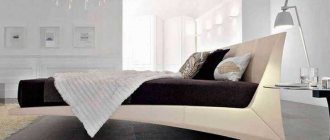When it comes to Soviet furniture, you most often hear 3 things:
- “The USSR never had its own furniture. It was brought from the GDR, Hungary, Czechoslovakia, etc.”
- "She was terrible to look at."
- “She was quality.”
Each of these statements can be argued. But we don't want to do this. Let's just plunge into the atmosphere of past years, look at the photos and remember what it really was like (yes, yes, it was) - Soviet furniture.
Types and styles of Soviet furniture
How did the production of household goods develop in the USSR? In what styles was Soviet furniture made? Let's look at these questions further.
Let's start with the fact that in pre-revolutionary Russia, furniture was produced mainly by hand or in a semi-handicraft way. Furniture factories were concentrated near St. Petersburg, Moscow, Riga, Kyiv and some other cities.
Under the USSR, industry began to gain momentum, and by 1940 the country already had many specialized enterprises in Moscow, Kharkov, Taganrog, Makhachkala, Gomel, Simferopol and other cities. They mass-produced simple and cheap furniture for the general population, as well as higher quality and “chic” products for new hotel and administrative buildings.
During the Great Patriotic War, factories, for the most part, were focused on producing a variety of goods for the front. Afterwards they were reorganized into sawmills and wood processing factories. It became possible to talk about the development of the quality and design of Soviet furniture only towards the end of the 1950s. But let's see what happened before that.
No. 3. Soviet thin-legged chairs
Here I will make a reservation that in the 50s several quite nice models of armchairs were made - after restoration they can become a worthy interior decoration. But the chairs, which were mass produced in the 60s and 70s, for the most part did not stand up to any criticism. These were almost identical massive products on thin lacquered legs. They weren’t particularly beautiful even in their new form, but today they look downright creepy.
If you need a chair, it is better to buy something modern and get rid of the old one. No need to scare your guests!
Soviet chair with thin legs
Soviet furniture in the 30−50s
The most suitable way to describe Soviet furniture of those times is the Empire style, or more precisely the “Stalinist Empire” , which combines Baroque, the imperial style of the era of Napoleon I and late classicism. Its main characteristics are some pomp and monumentality.
Thus, Soviet furniture was made of solid wood (often oak), had very impressive dimensions and, judging by its appearance, was capable of standing for 100 years. The wooden parts were decorated with elaborate carvings. Bright and patterned textiles were chosen for upholstered furniture. To complete the decoration, the interior was complemented by stucco, carpets, bronze lamps, painted ceramics and crystal (of course, in the homes of those who could afford it).
Among the most memorable models of Soviet furniture from the 30s to the 50s, it is worth noting sofas with a shelf and a mirror, massive cupboards for dishes and turnkey wardrobes with two compartments (for folding clothes and hangers).
However, the “Stalinist Empire style” was not destined to be improved or developed in any way. At the end of 1955, the USSR signed the Decree “On the elimination of excesses in design and construction.” Thanks to this, Soviet furniture in the minimalist .
Did you get out as best you could?
Until the early sixties, there was no mass production of furniture in the Union (in our understanding): standard bedside tables, shelves, cabinets, etc. were not cut from chipboard sheets. Furniture in those days was produced by small enterprises, as well as artels. Such furniture was usually made from solid inexpensive wood (pine laminated board), simple boards and plywood (the latter could be ordinary or veneered).
The photo below is an example of a typical 1950s kitchen. Wooden buffets and cabinets painted white were popular back then. Buffets were used to store and prepare food; dishes were stored in the glassed upper cabinet, and pots and other loose items were stored in the lower cabinet. On the buffet countertop they could, for example, cut food.
Typical fifties kitchen
Let's look at another example of what Soviet kitchens looked like before the sixties. The concept of “interior styles” did not exist for the people of that time; they furnished their homes with whatever they had to. Pre-revolutionary furniture was often found in kitchens, especially various types of sideboards and cabinets. They were made from high-quality wood, so they served for a long time; they got rid of them only when moving to small-sized “Khrushchev” apartments.
On a note! I. Utekhin, a famous St. Petersburg anthropologist, said that in the sixties and seventies, the dumps of Leningrad were full of antique furniture that simply did not fit into small apartments. It was thrown out, replaced with more modern chipboard furniture.
Pre-revolutionary furniture was often found in kitchens
. As for living rooms, they also did not look presentable in those days. The photo below is a vivid example of the traditional interior of those years: cheap “artel” furniture (see stools), ornate objects from pre-revolutionary times, handmade bookshelves. Furniture was usually placed around the perimeter of the room, with only a table in the center.
Furniture was usually placed around the perimeter of the room
A rich (by USSR standards, of course) interior could look something like this. The photo below shows expensive (again, by the standards of those years) solid veneer furniture made in the Art Deco style. Not every friend could afford such a set!
An example of a rich Soviet interior
The influence of the “thaw” on Soviet furniture
The next period, in which a new direction of Soviet furniture design was formed, occurred at the end of the 1950s and continued until the end of the 1970s. It was also called the period of the “Khrushchev Thaw”.
In 1957, the furniture industry of the USSR experienced its rebirth thanks to the signing of a decree on accelerating the pace of housing construction. His task was to provide apartments to as many people as possible in a short time. Therefore, these apartments (known as “Khrushchevkas”) were made very small and with low ceilings, in contrast to the same spacious “Stalinka” apartments. Accordingly, in such conditions, massive Soviet furniture from the 30s to 50s could no longer be in great demand. This was another reason why, at that time, USSR designers completely embraced minimalism.
Also read: Fashionable coffee tables in minimalist style
The main emphasis began to be placed on the production of furniture sets, rather than individual pieces of furniture. Such sets were developed specifically for 1-, 2- and 3-room apartments. At the same time, much attention was paid to convenience: the required configuration of a table, chair or cabinet was carefully calculated based on the average human height. To reduce the cost of furniture, chipboard, plywood and polymer materials began to be widely used. Efficient varnishing processes were also introduced into production.
Among the new types of furniture, it is worth noting a chair-bed, a sofa bed, simple low walls with or without legs, folding tables and kitchen sets.
Also read: Furniture Restoration: 25 Best Ideas on Pinterest
It is interesting that many products released in the USSR at that time were not inferior in quality and design to similar foreign models. Upholstered furniture, kitchen, living room and children's sets, despite their ascetic character and minimalism, looked very stylish and in their aesthetics were no worse, for example, than the same Danish and American products.
The furniture comes from the USSR. New - well forgotten old?
Author: Yulia Olkina
Pushing back the glass doors of the family closet, strong and simple in shape and handling, like a real Russian man, I carefully take out the festive crystal on the transformable table for large companies. A Czech wall, a German three-legged swivel chair, a lacquered piano with copper pedals, a bright red and yellow carpet... Have you already imagined yourself in the recent past? We didn’t even think about design, materials, or saving space. We just had it all, like many others. These apartments are similar to each other with the added comfort of home. Stamped interiors of Soviet apartments, where pieces of furniture were conscientiously assembled around a hot samovar. And although it sounds a little depressing, I remember this simple environment with the warmth and smell of pies.
You will be surprised, but furniture from the Soviet period had a way of making a statement. Not only did it really exist, but Soviet designers, in the process of their creative development, created truly interesting objects that are very reminiscent of the interiors of modern Ikea. And Alexander Semenov, a researcher of Soviet furniture design and a graduate student at the St. Petersburg State Academy of Arts and Industry named after. A.L. Stieglitz.
Second life of old furniture in a new interior
YULIA OLKINA: Tell us a little about yourself?
ALEXANDER SEMENOV: My area of interest constantly fluctuates between design and art. At the Academy (Stieglitz State University of Art and Industry), along with designing furniture and interiors, we were no less involved in drawing and painting. This is an interesting experience, since design for the most part belongs to the sphere of utilitarian principles, while art overcomes the boundaries of the functional. There are undoubtedly other approaches. For example, avant-garde artists of the 20s founded the “production art” movement, which assumed that artists should work for the benefit of building a new socialist world, go to factories and directly participate in the production process. This is how the first Soviet designers of mass products appeared and design was born. I understood that I was fascinated by theory and, perhaps, after some time it would help me return to practical design. But, after designing furniture for about 6 years, I decided to leave this business and immerse myself in research.
YO: Why Soviet furniture?
AS: Because this topic is still very little studied. I can’t say that I turned to Soviet furniture out of love. Rather, out of a desire to touch something unknown, to dispel some prejudices. I was surprised that there were so many books about Italian and Danish furniture design, but only small articles and short notes about Soviet furniture design. This is how my 3 books about furniture design in the USSR in the 1920s - 80s appeared. True, for now they exist only as samizdat, but I hope that the situation will change soon. I must say that in the process of studying the topic, I really fell in love with Soviet furniture, as something familiar and almost native. But, if there had already been extensive research on this topic, I would have done something else. The design of Soviet plumbing, for example)
YO: Stalin's Empire style and Khrushchev's minimalism. How did the mass construction plan affect the design of furniture, its quality, volumes?
AS: If we compare the mass furniture of the Stalinist period with the mass furniture of the Khrushchev period, then it will probably not be very correct to call the first “Stalinist Empire style”. It is important to understand that by this term we, first of all, mean pompous, expensive furniture designed for unique individual projects, such as the Central Theater of the Red Army or the Moscow Hotel.
L. I. Savelyev, S. A. Stapran, A. V. Shchusev. Interior of the Moscow Hotel. 1930s.
Mass-produced furniture was different. As for the decor, it could have laconic architectural cornices, several panels, discreet ornaments, or some other very laconic details. Another thing is that furniture in the 30s - early 50s was made mainly of solid wood and plywood, which made it visually more massive. Plus, the dimensions of the furniture corresponded to the housing being built at that time with relatively spacious apartments and high ceilings. In the 60s the situation changed. Architectural decorative details are almost completely eliminated from the furniture. Such popular materials as chipboard and fiberboard are widely introduced into mass production. They make it possible to make the walls of cabinet furniture thinner, which in turn leads to a reduction in the dimensions of objects. Largely thanks to new materials, it is possible to significantly increase and reduce the cost of furniture production.
Exemplary interior. 1960s
But we must be aware that the furniture of the Stalinist period is exactly as consistent with the idea of contemporary architecture as the interior equipment of Khrushchev’s “thaw”. And in this they are similar - design responds to the tasks assigned to it.
YO: The main association with furniture of the Soviet period is walls, “slides”. How did it happen that gloomy lacquered cabinets became a mandatory element of the interior of a Soviet apartment?
AS: The most interesting thing is that for those who bought them, the walls still seem very attractive. I suggest you look at the assortment of our modern furniture stores and try to find 10 differences from Soviet furniture. I think it's unlikely to be possible to do this. A fact about the state of modern Russian design is that the furniture we design for the most part is still very secondary and far from what can be abstractly described as good design. Often, when a person tries to justify himself (this is also a good question, why does he do this) for the appearance of a massive Soviet wall, the argument is used that nothing else could be found. They took what they had. Moreover, they most preferred foreign ones, for example, Yugoslav walls. They seemed more attractive and of higher quality. But this did not change their scale - they were just as massive and bulky as the Soviet-made ones. At exemplary furniture exhibitions, various wall options were offered, some of which were quite good, but in most cases they never reached the mass consumer.
YO: The main association with furniture of the Soviet period is walls, “slides”. How did it happen that gloomy lacquered cabinets became a mandatory element of the interior of a Soviet apartment?
AS: The most interesting thing is that for those who bought them, the walls still seem very attractive. I suggest you look at the assortment of our modern furniture stores and try to find 10 differences from Soviet furniture. I think it's unlikely to be possible to do this. A fact about the state of modern Russian design is that the furniture we design for the most part is still very secondary and far from what can be abstractly described as good design. Often, when a person tries to justify himself (this is also a good question, why does he do this) for the appearance of a massive Soviet wall, the argument is used that nothing else could be found. They took what they had. Moreover, they most preferred foreign ones, for example, Yugoslav walls. They seemed more attractive and of higher quality. But this did not change their scale - they were just as massive and bulky as the Soviet-made ones. At exemplary furniture exhibitions, various wall options were offered, some of which were quite good, but in most cases they never reached the mass consumer.
Zaveckienė L. Living room furniture set “Yubileyus”. Lithuanian SSR. June 6, 1972 Photo by Lyubshis K.
Another interesting fact is that, largely thanks to exhibitions of exemplary furniture, large walls are becoming fashionable. In the 60s, only rare projects featured furniture sets the length and height of a wall. The designers were aware that such items would clutter up the space of apartments in new buildings. But as a result of numerous public opinion polls conducted during exhibitions, furniture is gradually beginning to be made, so to speak, more spacious.
I think that there is no need to draw a clear line between “then” and “now”. The furnishings of a modern apartment, even with new furniture, often differ slightly from the much-hated “Soviet interior” and, on the contrary, some Soviet apartments will give a head start to many current projects.
Illustration from the book “Modern Furniture”. Mieczyslaw Puchała. 1966
YO: Soviet designers. Who were the brightest representatives?
AS: In the 1920s, it was definitely El Lissitzky, who summarized all the searches of avant-garde artists in the field of furniture design. He also developed the theory of furniture design. In addition, he introduced the concept of “combined” furniture, when various combinations can be made from standard elements: from a desktop to a couch.
Illustration from the book “Modern Furniture”. Mieczyslaw Puchała. 1966
In the Stalinist period, in my opinion, Boris Iofan distinguished himself, who, on the one hand, created things in the spirit of post-constructivism, and on the other hand, was not influenced by the trends towards excessive decoration that were popular in his time. His design for furnishing the infamous House on the Embankment is one of the masterpieces of Soviet furniture design.
B. M. Iofan. Armchair for the House on the embankment. Early 1930s
B. M. Iofan. Table. Early 1930s
And in the period of the 60s - 80s, the undoubted leader was Yuri Sluchevsky. His modular furniture system, easily changed depending on the interior, the height of a person and his needs, became iconic, and his name became firmly established in history.
Sluchevsky Yu. V. Modular furniture system.
YO: Division of space. What might a Soviet “studio” look like?
AS: Soviet studio is not an oxymoron at all. Exactly the same as now, along with one-room, two-room and other apartments, studios were built in Soviet houses. Only this name was not widespread. In the 20s, one of the analogues of a modern studio was the so-called “minimal living cell”.
Milyutin N. Project of a minimum residential cell for one person. 1930 Option for placing built-in equipment (interior perspective).
Milyutin N. Project of a minimum residential cell for one person. 1930 Option for placing built-in equipment (interior perspective).
This avant-garde project was rethought in the 60s, clearly indicating that such apartments were intended for singles and non-family members. Of course there were exceptions:
Furnishing of apartments. 1960s
In essence, the Soviet studio was not much different from modern ones. There were slightly different configurations, but nothing fundamentally changed: a small kitchen, through the efforts of a whole group of designers, is squeezed into a standard room of about sixteen meters and the result is what we now call a studio. You can often see deep niches for a bed, separated from the rest of the space by just a curtain. And of course, it is not surprising that many new residents, after moving in, demarcated the already small space with additional partitions and sliding doors.
Graphic sheet from the catalog of exemplary furniture.
There are also very interesting solutions that even now look modern. One such example is the interiors of the House of New Life in Moscow in 1971. Here the designers combined the kitchen, bedroom and living room into one space, but still made an additional small room, so to speak, just in case.
Equipment of the apartment of the House of New Life in Moscow. 1965 – 1971 Photo by N. Granovsky. TASS photo chronicle.
Equipment of the apartment of the House of New Life in Moscow. 1965 – 1971 Photo by N. Granovsky. TASS photo chronicle.
YO: What are the significant differences/differences between Soviet furniture and modern furniture?
AS: It is important to understand what period we are talking about. If we look at the furniture projects of avant-garde artists (mostly unrealized), we will notice clear differences in the materials used and stylistics, but the approach to design will be reminiscent of, for example, furniture from IKEA. The fact is that Soviet furniture does not have a common appearance, just like modern furniture. It is impossible to give a direct answer to this question. But we can try to highlight several characteristic trends in Soviet furniture design. The main one - a change in stylistic directions - occurred in parallel with perestroikas in power circles. In the 20s, as part of the fight against the “bourgeoisie” and the construction of a new socialist way of life, theses were put forward about the rejection of wastefulness and non-functional decor. The 30s, on the contrary, returned decor to furniture, forms became more massive, and avant-garde artists were persecuted. In the second half of the 50s, the so-called “Stalinist Empire style” was already criticized. At this time, designers turned their attention to the constructivist developments of the 20s. On this basis, the concept of “propaganda furniture” arose in the USSR. It clearly demonstrates the ideas of time due to some illustrativeness. Vivid examples would be I. Lobov’s display cabinet from 1925 or a table with legs in the shape of rifles from the turn of the 1920s – 30s.
Lobov I. Display cabinet. 1925
Table. The turn of the 1920s - 30s. Private collection.
In the 60s, the manifesto was expressed through other techniques, but what the furniture would be like was still decided by the top management. To put it very roughly, the design of Soviet furniture was largely dependent on the political situation within the country, which (I would like to believe) is not the case now.
YO: The forgotten old is returning, interest in typical furniture from the Soviet period is growing. How to combine the incongruous correctly?
AS: I believe that it is in the so-called attempt to combine the incongruous that the very sharpness that gives sound to the interior is often born. A person is always surrounded by objects from different historical periods. This is a given that we can accept or reject, as did some modernists who proposed projects for the complete demolition and rebuilding of entire cities from scratch. But now modernism is a thing of the past. In my opinion, if we do not want to bury history, then it is necessary not to preserve interiors and furniture, as classical museums do, but to include objects in our everyday life. And, if this is not easy to do with an 18th-century cabinet, then this trick will work with modernist furniture. How to do this is an individual question and there will be no correct answer here. The only thing I think you need to remember is not to go to extremes and not turn the interior of your apartment into a park from the Soviet period.
YO: How to find a middle ground between fashion trends and human needs. Ideal furniture, what is it?
AS: In my opinion, chasing the ideal is a very boring activity. I am absolutely convinced that even the most terrible Soviet wall will look interesting in the right context. The search for a golden mean is one of the same boring activities. I am for play, experimentation, variability, endless search, development of thought. To find an ideal or a golden mean would mean reaching a dead end. This does not mean that the goal of the search should not be the “golden mean” or “ideal”, but, in my opinion, one must keep in mind that there will be an infinite number of such “means”. So I recommend, as the creators of the experimental furniture set MEBAR said, “Be bold to experiment!”
Luchkova I. I., Sikachev A. V. Project MEBAR. 1975
Luchkova I. I., Sikachev A. V. Project MEBAR. 1975
Soviet furniture in the 80s and before the collapse of the USSR
Unfortunately, little good can be said about Soviet furniture after the early 80s. Aesthetics began to change rapidly and not for the better. So, for decorating the living room, they began to offer only the same type of “slides”. But even those were not particularly pleasing with their gloomy dark color, heavily polished surface that had to be constantly wiped, or chipping pieces of plywood covering.
As for the quality, it also began to gradually deteriorate. The legs and corners of the furniture began to deteriorate faster due to the use of low-quality plywood, metal and plastic fittings quickly became loose, and in general the design of the furniture left much to be desired.
It is precisely this type of furniture that everyone is rapidly trying to get rid of today. But as for the more “ancient” products from the 50s and 60s, we advise you to think carefully before throwing a Soviet bookcase (shelf, table, etc.) from those years into the street. They may need a little renovation, but they can still become a worthy element of your interior - after all, simple forms and minimalism are coming back into fashion! We will tell you about methods of restoring Soviet furniture in one of the upcoming articles on Dekorin. Stay with us!
UPD: Do-it-yourself restoration of Soviet furniture
No. 2. Sofa or ottoman
This piece of furniture, which usually has a niche inside for linen, ages very terribly (like the “wall”), after 25 years of use the legs become wobbly and crooked, the polish peels off, exposing the old crumbling chipboard, the upholstery becomes dirty, and the mattresses collapse . If you are still sleeping on such a miracle, you need to do something about it! Get rid of the Soviet ottoman, it’s better to buy something from IKEA - it will definitely be more attractive.
Ottoman 80s
No. 9. Soviet chandeliers
Sometime before the 60's there were nice lamps made from brass and glass and they can still look nice and vintage today. However, most - about 90 percent - of everything that was done later (especially the “crystal” things made of plastic with yellow “highlights” from time to time) now look poor and scary.
If your apartment is “decorated” by such a chandelier, quickly knock it down with a mop and throw it in the trash. Instead, you can buy something inexpensive and modern (for example, from the same IKEA).
Such a chandelier certainly will not decorate the interior
Such are the things. Be sure to tell us in the comments which of these items you still have in your home and whether you plan to get rid of them. It is very interesting to me.
No. 5. Kitchen furniture
In the Union, they didn’t make high-quality furniture for the kitchen at all, and what has survived to this day looks terrifying: chipboards swollen from temperature and moisture, crooked doors and faded fittings... Even cabinets with aluminum handles (see photo below, very popular in 80s) look bad now.
On a note! Such furniture should not be updated or restored, covered with something or painted - it will still look bad! It’s better to save up some money and spend money on a nice, modern kitchen.
Soviet kitchen furniture











